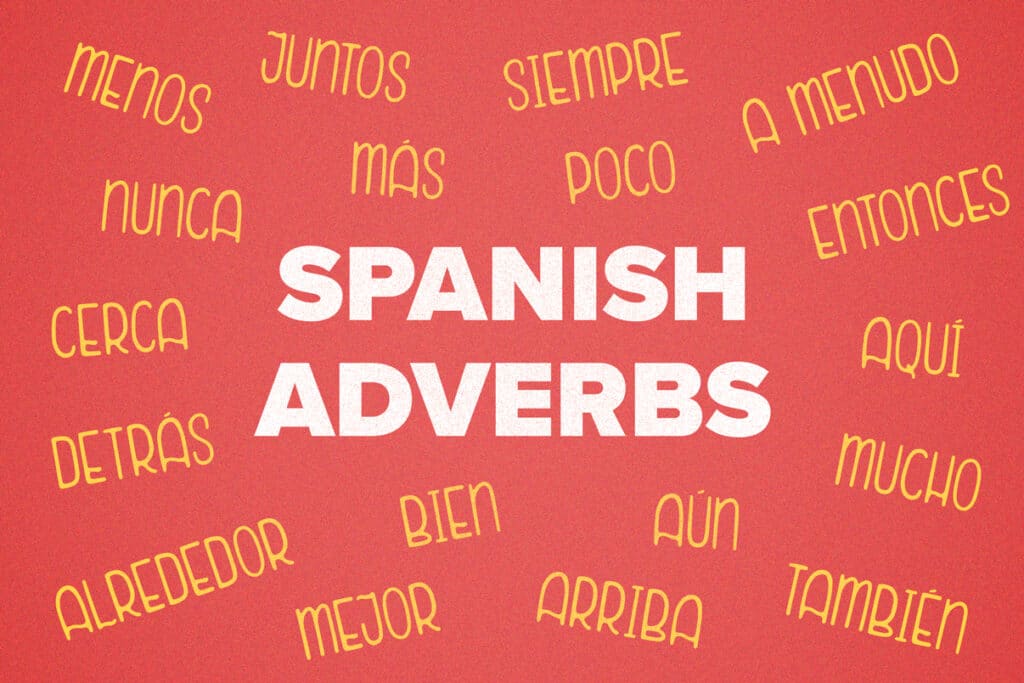
Spanish adverbs aren’t too difficult to understand, especially if you already know a bit about Spanish adjectives.
Adverbs are words that describe verbs, adjectives or other adverbs. For example, in the sentence “She walked very slowly past the house,” both “very” and “slowly” are adverbs.
Learning about adverbs will let you understand more details and descriptions in Spanish sentences, and also help you communicate with more nuance in your own Spanish speech and writing.
Contents
Download:
This blog post is available as a convenient and portable PDF that you
can take anywhere.
Click here to get a copy. (Download)
What Are Adverbs?
Adverbs are the words that are used to modify other words in a sentence, usually verbs (action words), adjectives (descriptive words) and sometimes other adverbs.
In Spanish, just like in English, there are dozens of adverbs that come in a variety of categories. An adverb can be used to define the frequency, speed, style, intensity or perspective of something. Adverbs also let you describe where something is or the direction it’s moving in.
Many of these adverbs are formed in a similar pattern to words you probably already know, which will make them fairly easy to recognize.
How to Create Adverbs in Spanish
In English, adverbs are often created by adding “-ly” to an adjective. In Spanish, adverbs are created by adding “-mente“ to the feminine form of the adjective.
Here are a few examples:
• accidentalmente
(accidentally)
• hermosamente
(beautifully)
• constantemente
(constantly)
Remember that not all adjectives have an exclusively feminine form, so sometimes they will just remain as they are. For example, claro (clear) will change to clara but alegre (happy) will not have to change:
• claramente
(clearly)
• alegremente
(happily)
As in English, this can’t be done with every adjective in Spanish, but it will work with a substantial portion of them. While some adverbs are not in this format, these are usually such common words that you’ll pick them up quickly.
100 of the Most Common Adverbs in Spanish
There are quite a few reasons you’ll need adverbs in a sentence, so there are many different categories that they fall under.
Here are some adverbs that will help you describe the place, frequency, manner, degree and time of an occurrence.
While you can find more outside of these categories, this list includes many of the most frequently used adverbs that you may encounter in almost every sentence in Spanish!
Adverbs of place
Here’s an example of aquí (here) in the song “Te fuiste de aquí” (You Left Here) by Reik:
Adverbs of frequency
To learn more Spanish adverbs of frequency, check out this post:
Adverbs of manner
Here’s an example of bien (well) as an adverb modifying a verb in Shakira’s song “No”:
Adverbs of degree
Here’s an example of mas o menos (more or less) in a video on how to make pita bread:
Adverbs of time
Here’s an example of hoy (today) at the end of a cooking video:
Adverbs of affirmation
| Adverb | Meaning | Example |
|---|---|---|
| sí | yes | Person 1: ¿Has llamado ya a mamá? (Have you already called Mom?) Person 2: Sí, la llamé ayer en la mañana. |
| también | also | Me dijeron que ellos también llegaron tarde porque no podían encontrar las llaves del coche. (They told me they also arrived late because they couldn’t find the car keys.) |
| cierto | true | Person 1: Recuerda invitar a Susana a la fiesta. (Remember to invite Susana to the party.) Person 2: Cierto, casi lo olvido. |
| obvio | obviously, of course | Person 1: ¿Ya tienes licencia de conducir? (Do you already have a driver’s license?) Person 2: Obvio, aquí está. |
| claro | sure | Claro, puedes venir a visitarnos cuando quieras. (Sure, you can come to visit us whenever you want.) |
| seguro | sure, certainly | Seguro que no habrá una segunda temporada de esa serie. (There certainly won’t be a second season of that series.) |
| asimismo | likewise | Asimismo, no está permitido fumar en los pasillos. (Likewise, smoking is not allowed in the corridors.) |
| efectivamente | indeed | Efectivamente, la última vez que vine fue antes del accidente de Marcela. (Indeed, the last time I came was before Marcela’s accident.) |
| indudablemente | undoubtedly | Indudablemente, eres uno de los mejores estudiantes de la universidad. (Undoubtedly, you’re one of the best students in the university.) |
| realmente | really, actually | Person 1: ¿Vienes por aquí seguido? (Do you come around here often?) Person 2: No realmente. |
Here’s an example of también (also) in an interview with the actress Ana de Armas:
Adverbs of negation
Here’s another example of tampoco (neither) from the song “Movimiento” (Movement) by Jorge Drexler:
Adverbs of doubt
| Adverb | Meaning | Example |
|---|---|---|
| quizá/quizás | perhaps | Quizá tenga que volver a casa porque no logro encontrar mi teléfono. (Perhaps I’ll have to go back home because I can’t find my phone.) |
| tal vez | maybe | Tal vez nuestro amor es imposible, pero no me rendiré. (Maybe our love is impossible, but I won’t give up.) |
| acaso | perhaps, by any chance | ¿Acaso pensás que soy un cajero automático? ¡No te daré más plata! (Do you think I’m an ATM, by any chance? I won’t give you any more money!) |
| igual | anyway, even so, regardless | Igual tenemos que trabajar el domingo. (Anyway, we have to work on Sunday.) |
| a lo mejor | maybe, probably, at best | A lo mejor Alfonso no sabe que estamos aquí. (Maybe Alfonso doesn’t know we’re here.) |
| lo mismo | maybe | Lo mismo vuelvo cansado y me voy a la cama. (Maybe I’ll come back tired and go to bed.) |
| al parecer | apparently | Al parecer, necesito un permiso de obra para renovar la cocina. (Apparently, I need a construction permit to renovate the kitchen.) |
| aparentemente | apparently | Aparentemente, no todo lo que brilla es oro. (Apparently, all that glitters isn’t gold.) |
| posiblemente | possibly | Posiblemente te elija a ti porque tienes más tiempo libre. (I’ll possibly choose you because you have more free time.) |
| probablemente | probably | Probablemente no es nada serio, pero necesito confirmarlo. (It’s probably nothing serious, but I need to confirm it.) |
Here’s another example of tal vez (maybe) from a scene from the show “Friends”:
Adverbs of question and exclamation
Here’s another example of cómo (how) from “The Little Mermaid”:
Relative adverbs
| Adverb | Meaning | Example |
|---|---|---|
| donde | where | Esta es la cafetería donde Juana y yo nos conocimos. (This is the cafeteria where Juana and I met.) |
| hacia donde | to where, to which | Aquella es la tienda hacia donde se dirigen todos los niños. (That’s the shop to which all the children are headed.) |
| desde donde | from where, from which | Esta es la ciudad desde donde se expandió el virus. (This is the city from where the virus spread.) |
| al que / a la que |
to which | Ese es el gimnasio al que siempre voy. (That’s the gym [which] I always go to.) |
| en el que / en la que |
where, in which | Por favor, muéstreme la universidad en la que estudió medicina. (Please, show me the university where you studied medicine.) |
| del que / de la que |
from where, from which | Esta es la ciudad de la que vengo. (This is the city [where] I come from.) |
| por el que / por la que |
through which | ¿Me podés mostrar la ventana por la que lanzaste la pelota? (Can you show me the window through which you threw the ball?) |
| cuando | when | Cuando deje de llover, iremos a la biblioteca. (When it stops raining, we’ll go to the library.) |
| como | as, like, the way | Debemos hacerlo como nos dijo mamá. (We should do it the way Mom told us.) |
| cuanto | as much as, all | Coman y beban cuanto quieran. (Eat and drink as much as you want.) |
If that feels like a lot, it can help to split up words by themes (like we did) and try to find the English words hiding inside them (like the word “annual” in anualmente).
Another great way to learn adverbs is through authentic videos, and you can find plenty of these on FluentU.
How to Use Spanish Adverbs in Sentences
Adverbs are used for modifying other words in the sentence, so naturally they almost always are located next to the word in the sentence that they’re modifying.
Here are the three situations in which adverbs are used in Spanish:
First is perhaps the most common way adverbs are used, which is to modify verbs. These adverbs describe how an action is being done, and are usually located directly before or after the verb itself.
Ella esperó pacientemente.
(She waited patiently.)
Rápidamente corrió hacia la salida.
(Quickly, he ran towards the exit.)
Adverbs are also used to modify adjectives, which modify nouns. They most often tell us about the frequency or degree of the adjective and are usually located directly before the adjective they’re modifying.
El servicio es usualmente bueno.
(The service is usually good.)
El norte es increíblemente frío.
(The North is incredibly cold.)
Finally, adverbs can also modify other adverbs. In this case, they usually go directly before the adverb they’re modifying.
La mujer sonrió muy alegremente.
(The woman smiled very happily.)
El lugar está bastante lejos.
(The place is quite far.)
If you want to use two adverbs to describe a verb, only the second one will use the standard form for adverbs (with the “-mente” suffix). The first adverb in the sentence will remain an adjective in its feminine form:
Ella habla lenta y suavemente.
(She speaks slowly and gently.)
Adverbs that show point of view usually go at the beginning of a sentence. This is the same as the way we do it in English:
Personalmente, no lo disfruto.
(Personally, I don’t enjoy it.)
How Native Speakers Use Spanish Adverbs
We’ve covered the grammatically correct way to use Spanish adverbs, but it’s important to note that native speakers don’t always speak with perfect grammar.
Just like an English speaker might say something like “He talks super loud” instead of “loudly,” Spanish speakers often leave off the -mente ending as well.
For example, you might hear something like “Hice el trabajo rapido”
(I did the work quickly) instead of the correct form of the adverb, rápidamente.
While such deviations may occur in casual conversation, formal or written Spanish typically adheres to proper adverb placement and form.
How to Practice Spanish Adverbs
There are tons of resources available for you to further your knowledge and comprehension of Spanish adverbs. And the best part is most of them are free and available online!
Here are a few suggestions to get started:
- Read short stories or passages in Spanish: This post has short stories in Spanish for beginners through advanced learners. There is also a free online international library of lower-level books of all types in both Spanish and English.
- Quiz yourself: Study Spanish has some adverb quizzes available, not only for reading and writing but also for listening and speaking.
- Watch lectures online: The YouTube channel Butterfly Spanish gives you the classroom vibe and teaches a wide variety of topics in Spanish, including adverbs. It even accepts suggestions from its viewers for what to teach next! Check out their video lesson on prepositions and adverbs:
With some practice, you’ll be able to use adverbs in Spanish with confidence and ease.
Download:
This blog post is available as a convenient and portable PDF that you
can take anywhere.
Click here to get a copy. (Download)
And One More Thing…
If you’ve made it this far that means you probably enjoy learning Spanish with engaging material and will then love FluentU.
Other sites use scripted content. FluentU uses a natural approach that helps you ease into the Spanish language and culture over time. You’ll learn Spanish as it’s actually spoken by real people.
FluentU has a wide variety of videos, as you can see here:
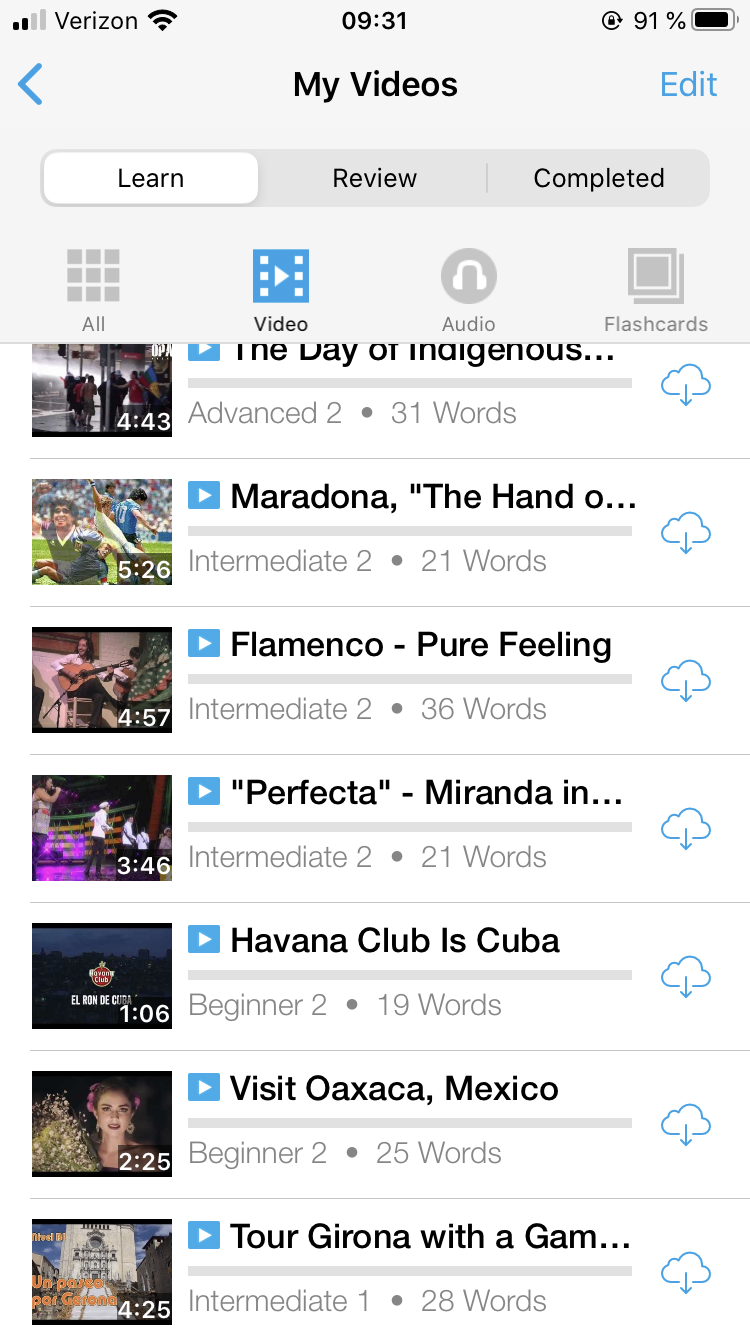
FluentU brings native videos within reach with interactive transcripts. You can tap on any word to look it up instantly. Every definition has examples that have been written to help you understand how the word is used. If you see an interesting word you don’t know, you can add it to a vocab list.
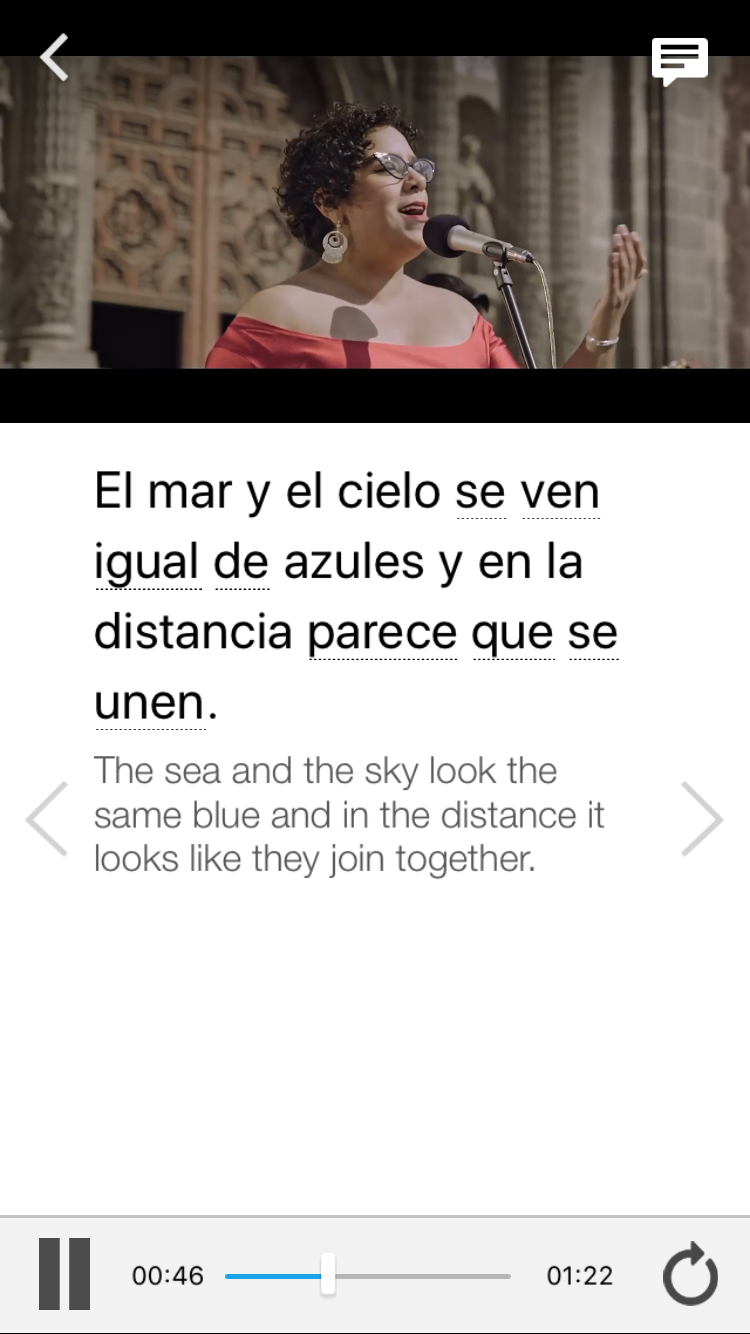
Review a complete interactive transcript under the Dialogue tab, and find words and phrases listed under Vocab.
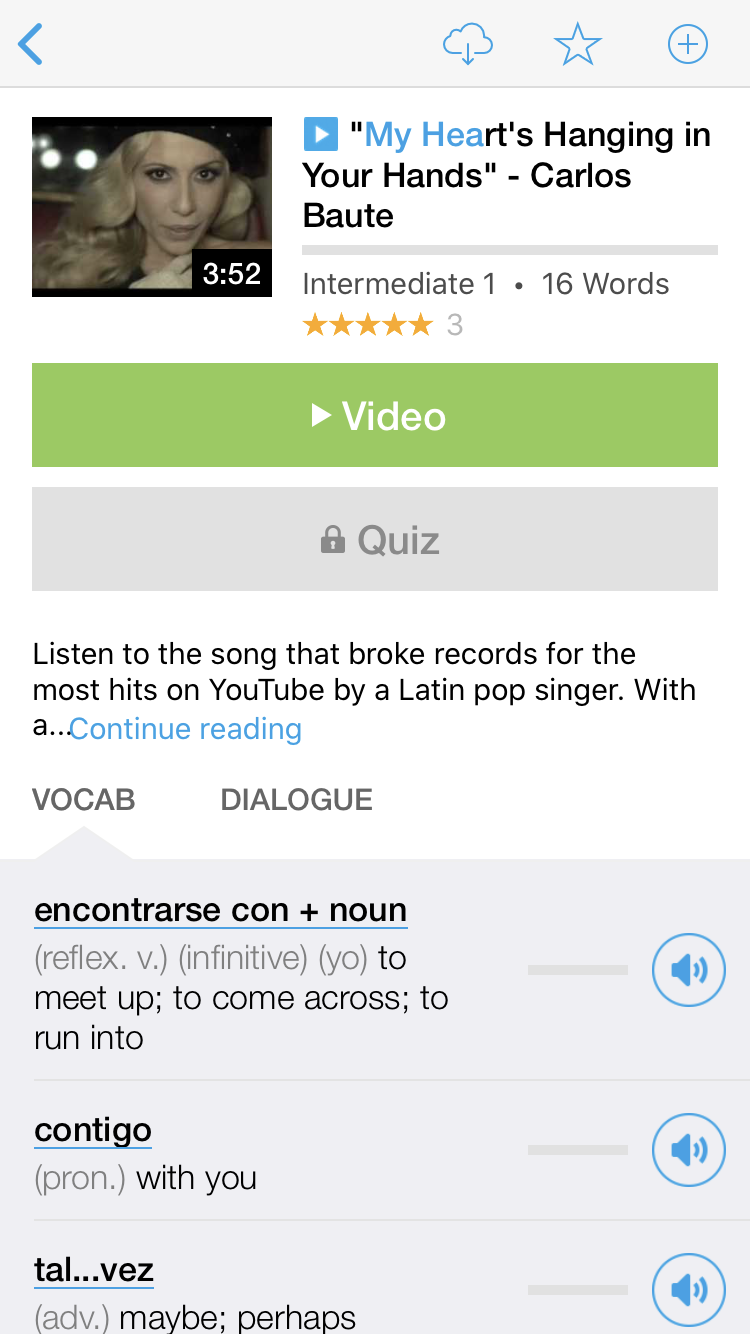
Learn all the vocabulary in any video with FluentU’s robust learning engine. Swipe left or right to see more examples of the word you’re on.
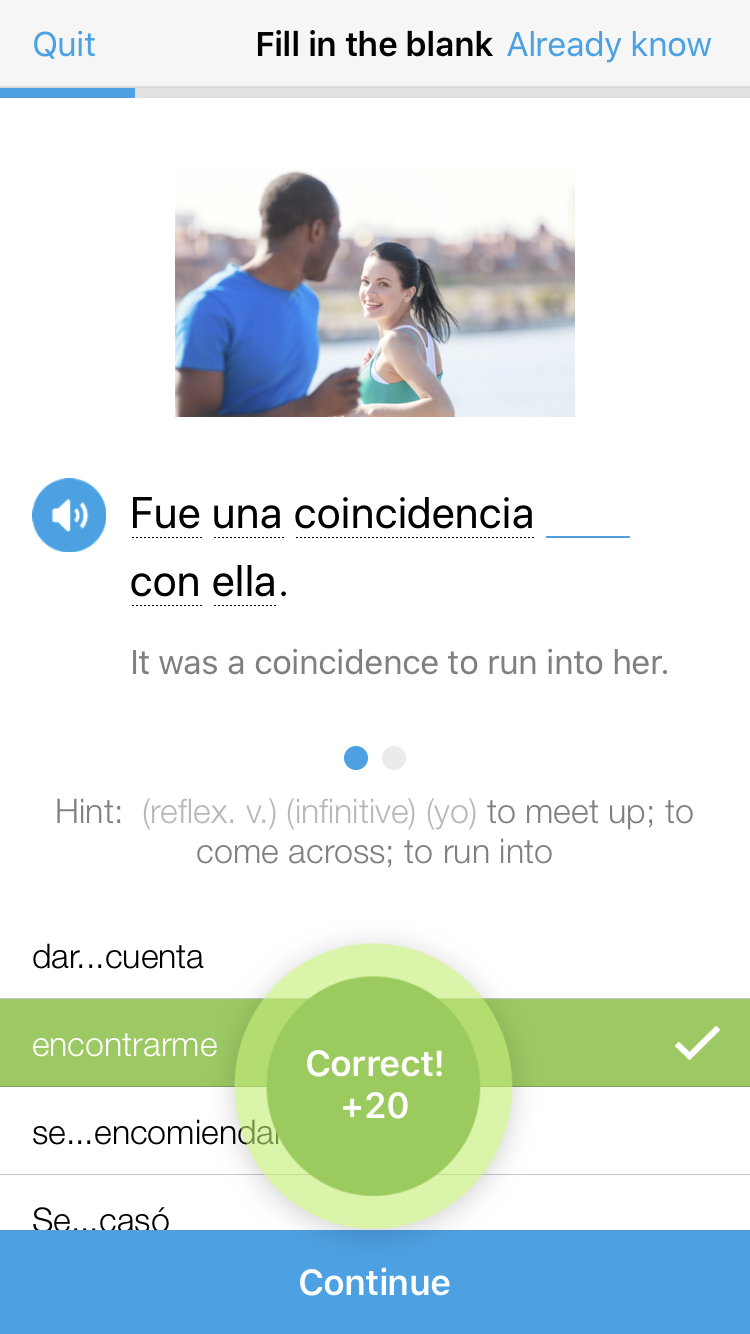
The best part is that FluentU keeps track of the vocabulary that you’re learning, and gives you extra practice with difficult words. It’ll even remind you when it’s time to review what you’ve learned. Every learner has a truly personalized experience, even if they’re learning with the same video.
Start using the FluentU website on your computer or tablet or, better yet, download the FluentU app from the iTunes or Google Play store. Click here to take advantage of our current sale! (Expires at the end of this month.)



